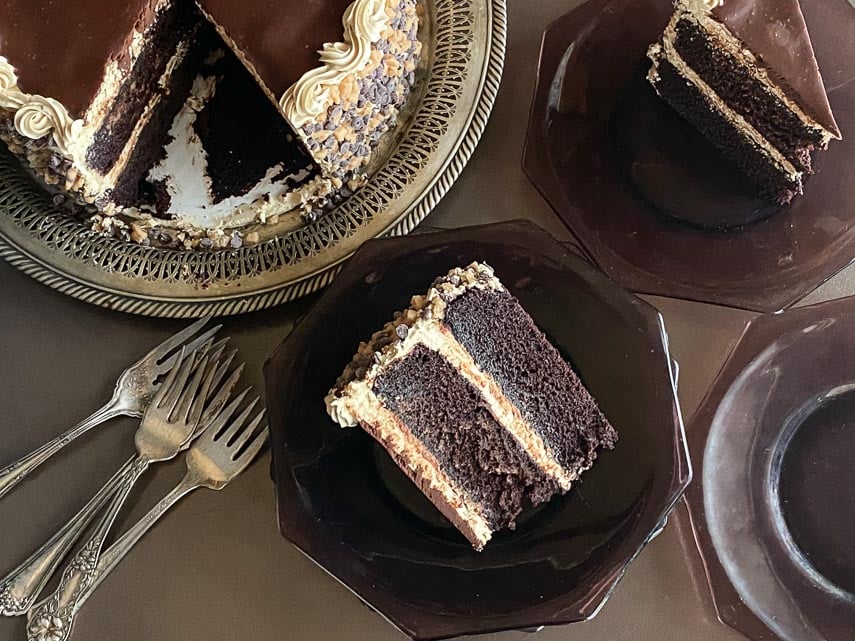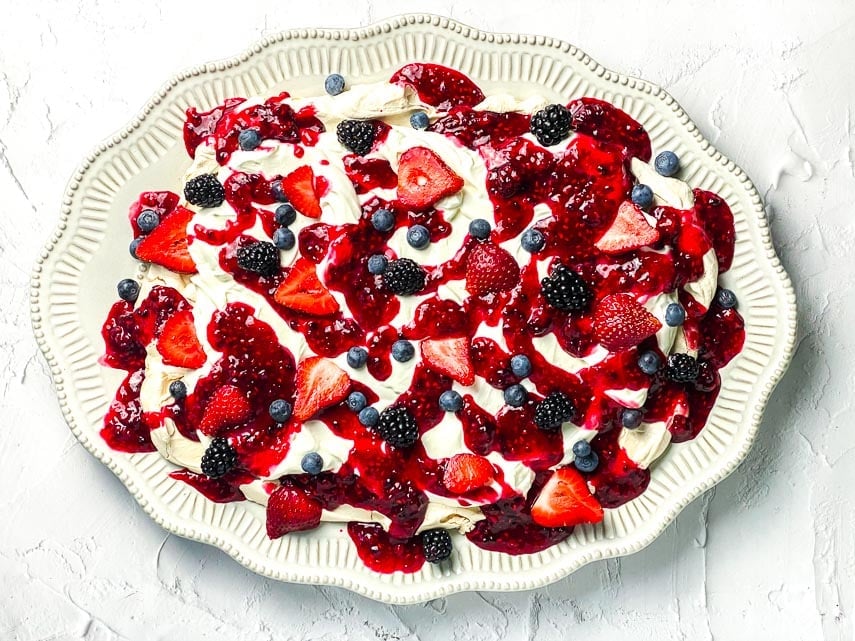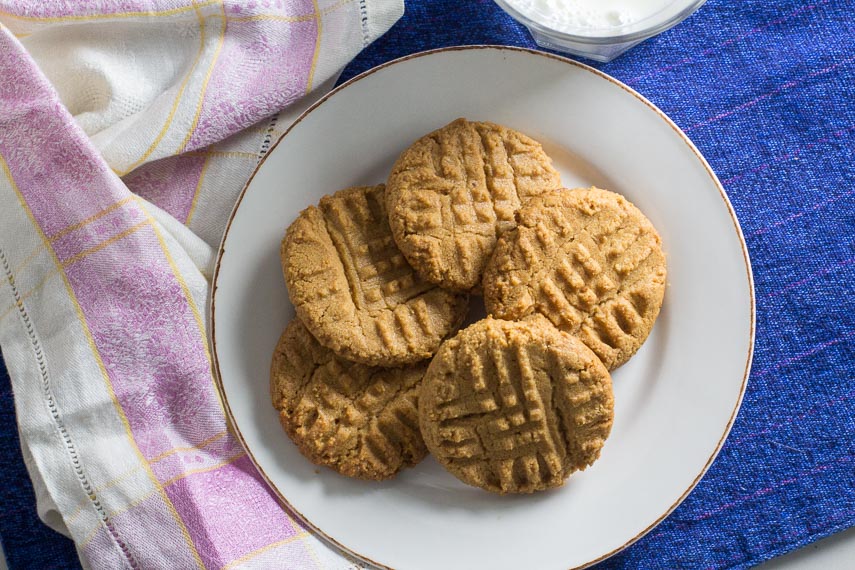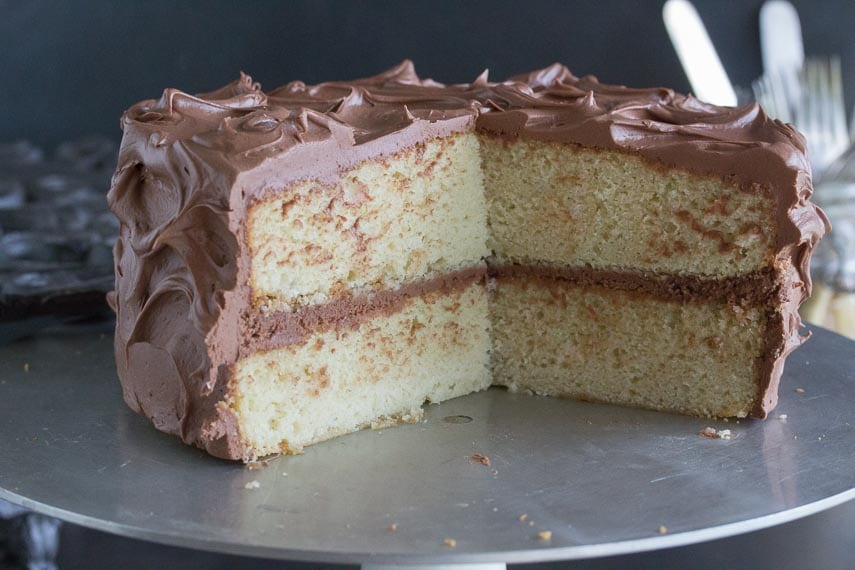Is sugar low FODMAP? White granulated sugar actually contains no FODMAPs at all! This is the one article you need to learn everything you want to know about sugar, sweeteners, non-nutritive sweeteners (NNS), sugar substitutes, and the low FODMAP diet.
Learn about the different types of sugar, how they are used in cooking and baking, and what amounts are recommended for low FODMAP eating, even during the Elimination Phase. This article is the most up-to-date and comprehensive anywhere, and includes exclusive information directly communicated by Monash University researchers.
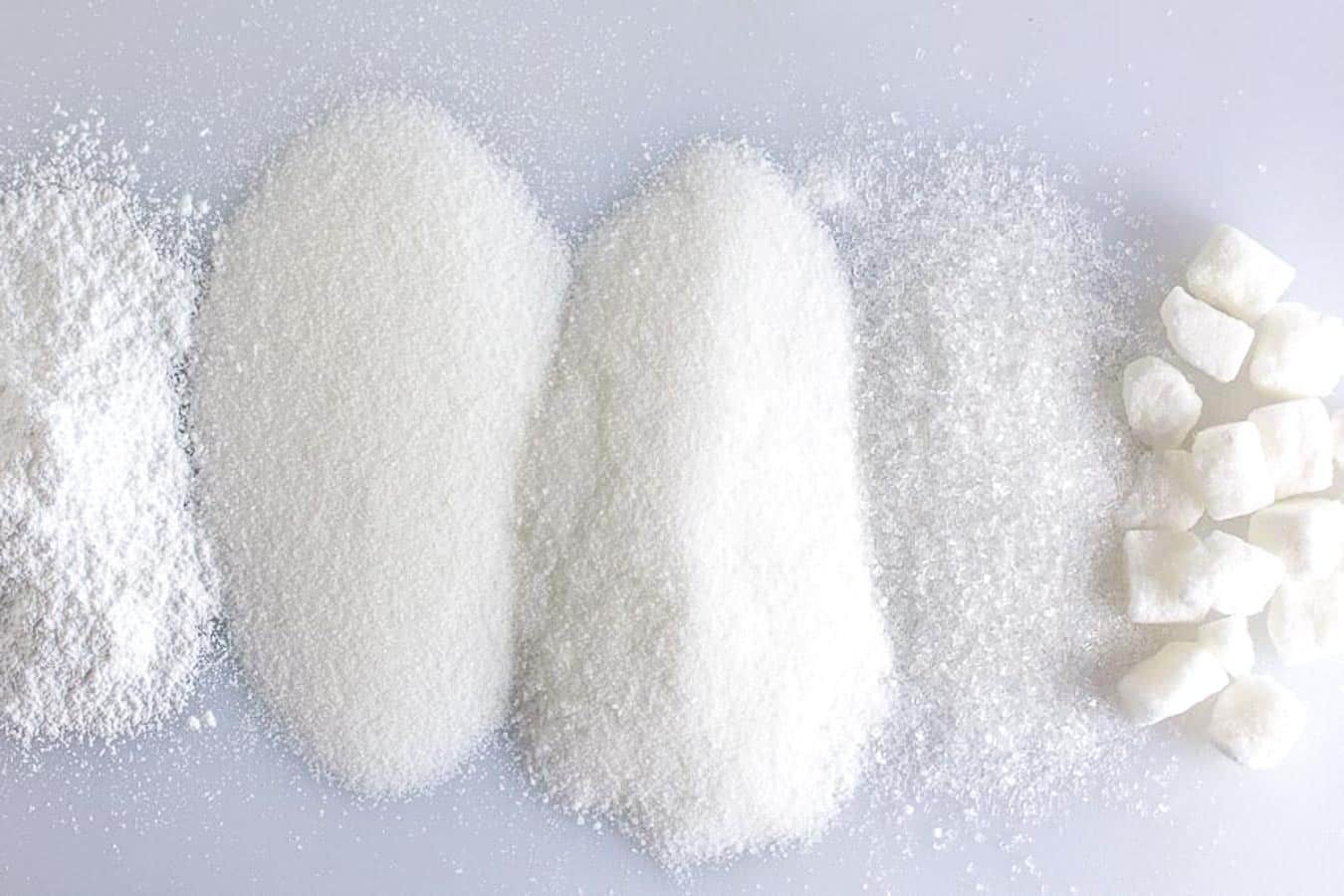
We also have an updated section on Non-nutritive Sweeteners and Gut Health written by Kathryn Adel MS RD CSSD LD.
- Let's Talk About White Sugar
- Brown Sugars: Light & Dark
- Liquid Sweeteners
- Corn Syrup Vs. High Fructose Corn Syrup
- Polyols
- Other Sugars, Sweeteners & Sugar Substitutes
- Non-Nutritive Sweeteners and Gut Health
- How to Use Sugar
- Substituting Sugars In Recipes
- Can I Reduce Sugar In Recipes?
- How to Store & Measure Sugar
- The Takeaway
- Low FODMAP Recipes with Low FODMAP Amounts of Sugar
Let’s Talk About White Sugar
Also referred to as granulated sugar or simply “sugar” in our FODMAP Everyday® recipes, there are many questions revolving around sugar from a FODMAP perspective. (Conventional white granulated sugar can be seen in the center of the image, above).
- We use Domino brand cane sugar in our Test Kitchen.
Is Sugar Low FODMAP?
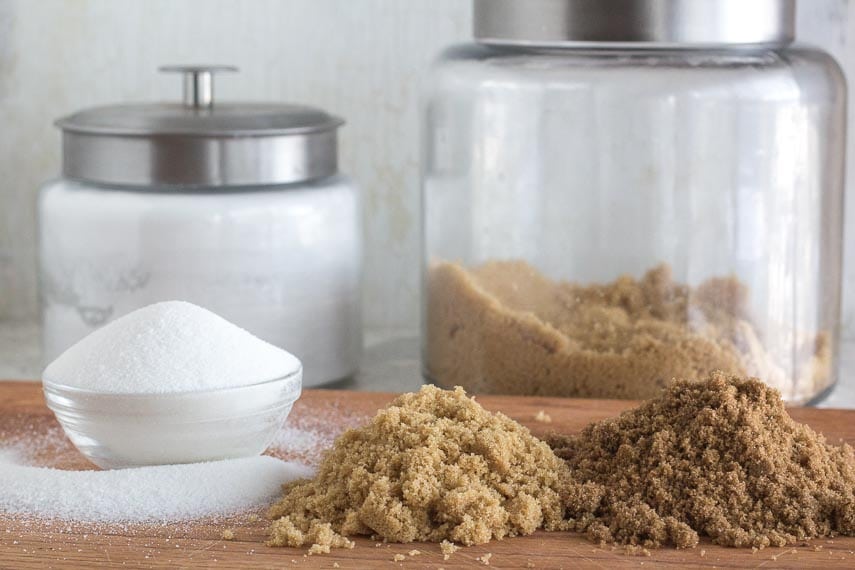
White sugar contains no FODMAPs. Sugar is a disaccharide, due to the fact that it is made up of fructose and glucose. The “D” in FODMAP does indeed stand for disaccharide, however, white sugar has equal amounts of fructose and glucose and therefore does not meet the definition of a FODMAP, according to Monash University.
How Are Recommended Sugar Levels Calculated by Monash?
The suggestion that an appropriate serving of sugar be held to ¼ cup (50 g) is based upon general Australian governmental healthy eating guidelines – not related to FODMAPs. You could eat as much sugar as you wanted, and the amount would never be high FODMAP. This is not to suggest that this is a good idea!
It is important to note that these government guidelines are used throughout the app. Please read our article on What Is A Low FODMAP Serving Size? to learn more about how serving sizes are determined. It is not how you probably think they are.
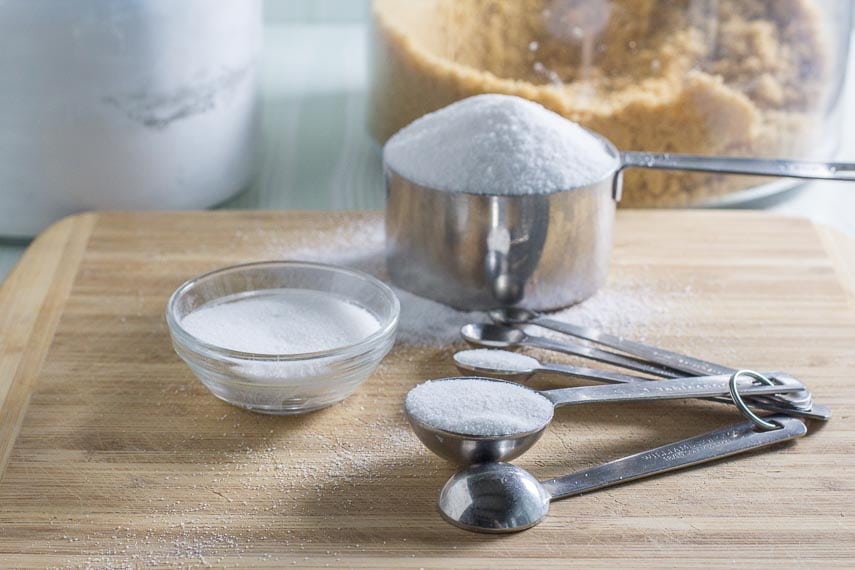
How Much Sugar Can I Eat?
Even though sugar contains no FODMAPS, it can be an IBS trigger for some; know your tolerances.
We eat home baked goods made with sugar, brown sugar, confectioners’ (icing) sugar as well as maple syrup, rice syrup, honey, and small amounts of molasses. That said, we do not eat cakes and cookies, muffins and scones every day.
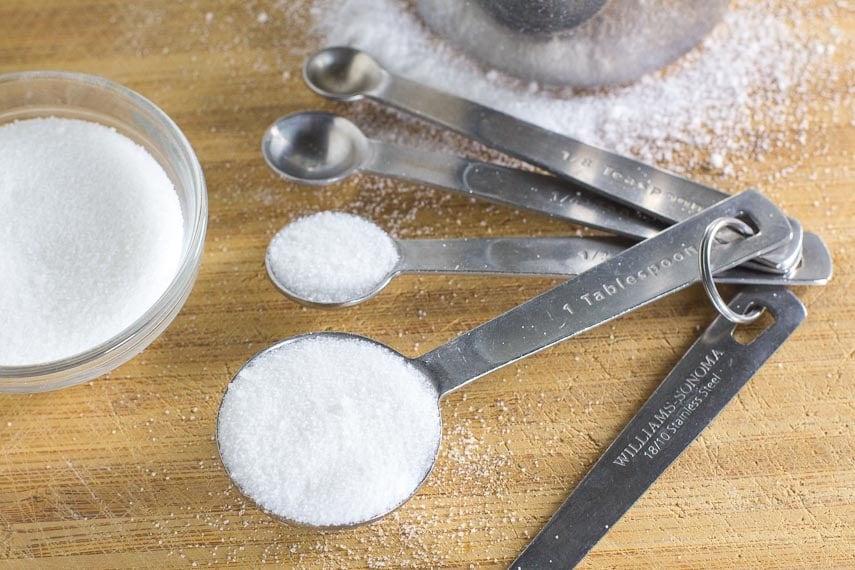
Use your judgment. Enjoy a slice of birthday cake on your special day; have a muffin while you enjoy the Sunday paper; have a piece of chocolate every now and then – just not all the time.
When you read about sugar being an issue, it is hidden sugars that are a big problem: sugars in bread, condiments, sodas, etc. Not Grandma’s holiday cookies you eat once a year; have a cookie!
Cane Sugar vs. Beet Sugar
While we use the term “sugar” to denote plain, white granulated sugar, let’s talk about what it is made from. Most sugar that you buy in the supermarket baking aisle will be derived from sugar cane, and most packaging will state this, however, some sugar is made from sugar beets. Neither have an excess of fructose, so there is no difference from a FODMAP perspective.
There is a .05% chemical differential between cane sugar and beet sugar and the variance is probably due to mineral content and the plant source, but since they are also processed differently, any dissimilarity could stem from that as well. Also note that beet sugar is often genetically modified (while cane is not) and contains sulfites, which can be an issue for those who are sensitive.
They taste the same, although there is discussion within the professional baking community about whether they are interchangeable. The argument is that although they are almost the same from a chemical standpoint, beet sugar melts and caramelizes differently and therefore is especially problematic for candy makers and confectioners. Some bakers also claim that beet sugar produces a coarser crumb.
When you think about the fact that sugar cane grows above ground and sugar beets below and that they are different plants, it isn’t surprising that certain variables can become apparent.
Superfine Sugar
From a FODMAP perspective, superfine sugar is the same composition as white sugar. It contains no FODMAPs.
Also known as bar sugar, extra-fine or caster sugar, this is the finest textured of the granulated white sugars. It is popular with bartenders, as its fine texture means near-instant dissolving properties, even in cold drinks. This is also why some recipes for meringues call for it; it dissolves within the egg whites more readily than regular granulated. You can put regular granulated sugar in your food processor and grind it to a finer consistency and use it in recipes where superfine is recommended, such as some angel food cakes or meringue recipes. It will lose some of its crystalline sparkle, however, so if you need superfine sugar for its look to coat sugared fruit or candied orange peel, use commercially prepared superfine sugar.
Many resources will tell you that regular and superfine can be substituted cup for cup. Their density is different, however – more superfine sugar measures into a cup than regular granulated – but many recipes will work with either, although not necessarily giving exact results. This is where trial and error comes in with specific recipes and we leave it to you to decide on an individual basis.
- We use either Domino or India Tree brands of superfine sugar in the Test Kitchen.
Confectioners’ Sugar
The Monash app calls this “icing sugar” and a suggested serving is set at 1 (Australian) tablespoon or 16 g. FODMAP Friendly also has a low FODMAP serving if 1 tablespoon (16 g) and also shows a max low FODMAP serve of 336 g, which is well over 1 cup.
There used to be very important fine print on the Monash app, that told us that it did not even become moderate in FODMAPs until 500 g, which is a very large serving. Monash removed that language, but the facts remain. Powdered sugar is simply finely milled white sugar, which contains no FODMAPs. The fact that the lab tests showed FODMAPs at larger servings probably means they lab tested confectioners’ sugar, which is not the same, but this is conjecture.
Confectioners’ and powdered sugar are technically different. Confectioners’ sugar usually has 3% cornstarch added, which some say leaves a raw taste when used in unbaked applications, such as when sweetening whipped cream. If your confectioners’ sugar contains cornstarch, don’t worry, as it is considered low FODMAP in 2/3 cup (100 g) amounts, which is a large amount.
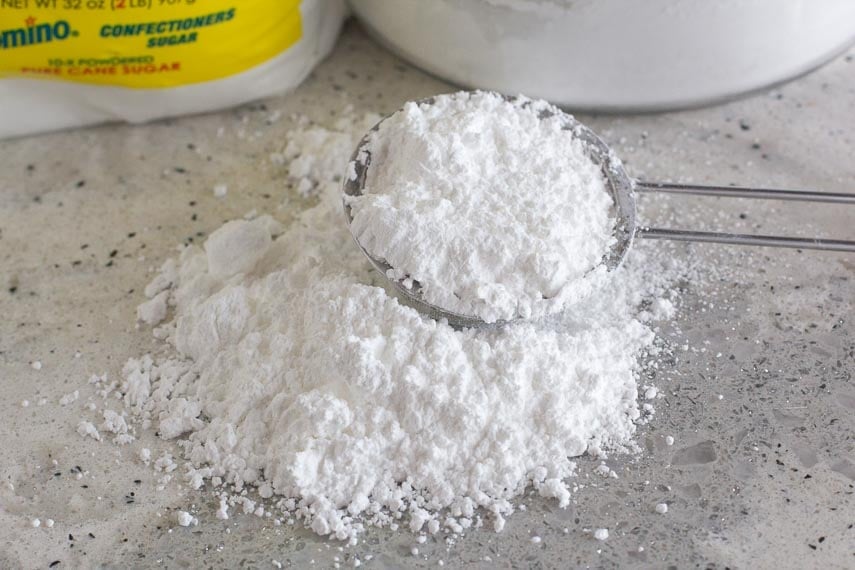
Read labels to know what you are buying and using. Sometimes labels say “10x,” which refers to the fact that that product it is 10 times finer than granulated sugar.
- We use Domino brand of confectioners’ sugar in the Test Kitchen
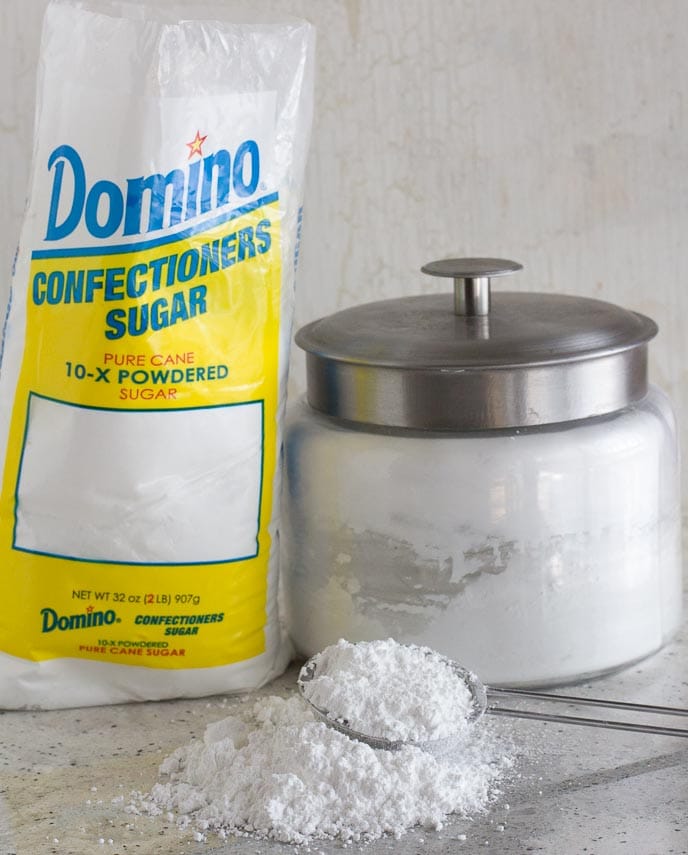
Fondant Sugar
Use the weight of confectioners’ sugar in the Monash app to determine suggested low FODMAP serving size of fondant sugar.
This is also called icing sugar in the U.S. and elsewhere and is like super-duper fine powdered sugar, 1/100th of the size of most confectioners’ sugar. It dissolves quite rapidly and creates ultra-smooth fondants and icings based on powdered sugar.
Fondant sugar often contains cornstarch as well. Read labels.
- We use India Tree brands of fondant sugar in the Test Kitchen.
Sanding Sugar
Sanding sugar is just another variation of white sugar. It contains no FODMAPs.
This sugar is used for decorating cookies, cakes and other baked goods and the granules are in-between regular granulated sugar and coarse sugar (see below) in size. Their larger size and irregular shape allows them to sparkle and also not melt when exposed to heat, such as when they are sprinkled on sugar cookies.
We use many different brands of sanding sugar but particularly like Wilton, as they are easy to find and they offer many colors, including metallic, such as gold and silver.
Coarse Sugar (Decorating Sugar; Decorative Sugar; Sparkling Sugar)
Coarse sugar is just another variation of white sugar. It contains no FODMAPs.
Coarse sugar, also referred to as decorating sugar, decorative sugar, sparkling sugar and sometimes crystal sugar is also used for decorating cookies, cakes and other baked goods. The granules are coarser than sanding sugar (above). Their larger size and irregular shape make them particularly sparkly. They will not melt when exposed to heat.
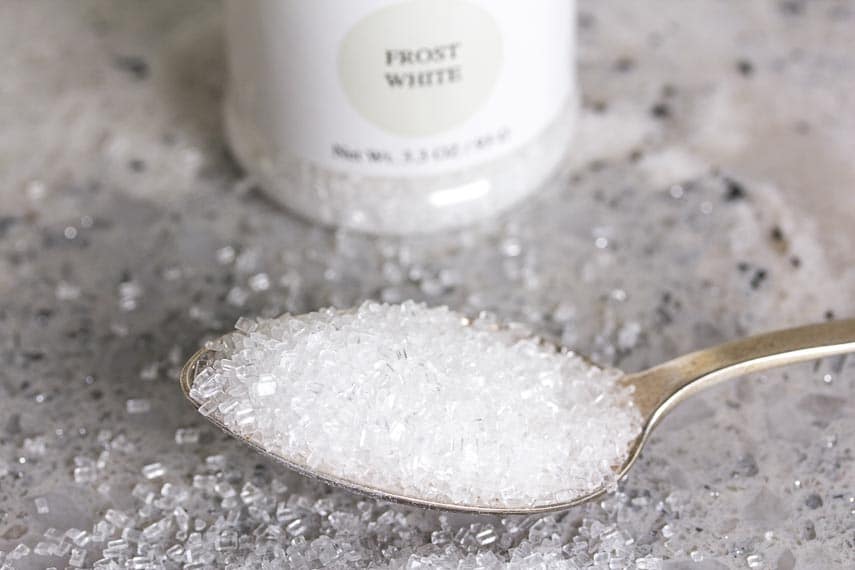
We use many different brands of coarse sugar but particularly like Wilton, as they are easy to find and offer many colors.
Pearl Sugar
Pearl sugar is just another variation of white sugar. It contains no FODMAPs.
This is a highly specialized sugar that is used in some bakery applications. It is also referred to as Swedish pearl sugar, Belgian pearl sugar or nib sugar and it is very coarse and opaque and will not melt easily. It is most commonly seen in Belgian waffles, where the coarse sugar, when exposed to the direct high heat of a waffle iron, softens and caramelizes creating a unique crunch and texture.
- If you are interested, try Lars Own brand or King Arthur.
Sugar Cubes
Sugar cubes are just another variation of white sugar. They contains no FODMAPs.
Sugar cubes are made from regular granulated sugar that is combined with a little water or steam and then shaped in molds to form the familiar cube shape. The sugar is slightly melted by a small amount of heat, allowing it to retain its shape, and the cubes are then quickly dried to remove any moisture.
- India Tree Pure White Sugar Cubes are lovely for your next tea party.
Brown Sugars: Light & Dark
The Monash app sets their suggested low FODMAP serving for brown sugar at ¼ cup (40 g). FODMAP Friendly suggests a low FODMAP serving of 1 tablespoon (13 g), but shows a max low FODMAP serve of 273 g (well over 1 cup).
In personal communication, Monash told us that brown sugar showed no FODMAPs.
Both beet and cane sugars can be used to make brown sugar, but they are made differently.

If derived from sugar cane, a certain proportion of the molasses that is inherent in the plant may be left in during processing or it may be stripped away and added back to processed white sugar. The former is referred to as “boiled brown” and the latter is called “painted brown” (both industry terms). If you have heard that brown sugar is refined white sugar that has molasses added back in, that can be true and that is the so-called “painted” version.
If it is derived from sugar beets, it is always “painted brown”. To make things even more interesting (to me, anyway, since I am a sugar nerd) the molasses derived from sugar beets does not taste very good; it is usually sold off for use in animal feed. So, the molasses that is “painted” back onto beet sugar to make brown sugar is indeed molasses that has come from sugar cane production!
According to sugar-beet-industry experts from Michigan Sugar, the difference in light and dark brown sugars is not necessarily that there is more molasses added to the dark brown, rather that a different blend of molasses is used. There are different grades of molasses made during sugar production, and they will have different sensory profiles that affect color, taste and aroma. Different blends are also used for light and dark.
- We use Domino brand brown sugars in the Test Kitchen.
Muscovado Sugars
These have not been tested by Monash, but they are a type of brown sugar. You can try them on your own and assess their digestibility. Dark brown Muscovado sugar does appear in a product lab tested and certified low FODMAP by FODMAP Friendly, so we do know there is a low FODMAP amount.
This is a type of cane sugar that is sometimes described as unrefined (Billington’s uses this term, but they are essentially just less refined) and comes in light and dark versions. Muscovado sugars are natural, cane derived, brown sugars in the sense that the molasses they contain was never stripped away (some commercial brown sugars are made by re-combining refined white sugar with molasses that had been removed during the refining process, as described above). Muscovado sugars have a much stronger flavor profile than conventional brown sugars and usually a higher moisture content as well. You can see in the image above that the conventional dark brown sugar, front left, is about the same color as the light muscovado in the bag, rear right.
Light Muscovado: This version is closest perhaps to common dark brown sugar. It has more pronounced molasses flavor than commercial brown sugars and should be used when that strong, natural flavor can be showcased. Try it in a chocolate cake, lighter gingerbreads or spice cake.
Dark Muscovado: Also called Barbados sugar. This sugar tastes deeply of molasses with a bitter edge that works well in dark and sticky gingerbreads, barbecue sauce or anywhere you want a rich, pronounced molasses flavor.
We use Billington’s Muscovado sugars in our Test Kitchen.
How to Soften Brown Sugar
One problem bakers often encounter is hardened brown sugar. If it is kept in an airtight container, it will retain its moist, packable texture but if exposed to air it can become as hard as a rock! We transfer our brown sugar from the bag it is packaged in to glass, airtight containers to prevent this from happening. But if it does, you do have recourse! An old-fashioned approach suggests placing a slice of moist apple or a piece of bread in your container of hard brown sugar, closing it up tight and allowing it to sit over night or for a couple of days. The moisture from the fruit moistens the brown sugar, but the downside here is you would have had to plan ahead – and we never have high FODMAP apples around anymore.
A near-instant way to soften it is to lightly moisten a paper towel, seal it up in your container of hard brown sugar and microwave it in 10-second bursts on high power. Depending on the power of your microwave, and how hard your sugar is, this might take up to 30 seconds but probably not more. We like this trick a lot and it works every time. You can also try prevention and use a brown sugar saver – we love this little brown bear!. These are small pieces of terra cotta, often in decorative shapes, that you insert in your brown-sugar storage container after a brief soak in water. They work similarly to the apple, but they can live in your sugar storage indefinitely.Or, you can buy an airtight container that has the terra cotta piece built-in.
- Brown Sugar Bear Original Brown Sugar Saver and Softener, Terracotta
- Prepworks by Progressive Brown Sugar ProKeeper
Liquid Sweeteners
This section presents what you need to know about FODMAPs and molasses, maple syrup, honey, agave, brown rice syrup, golden syrup, sorghum syrup, and barley malt syrup.
Molasses

Monash University has lab tested molasses and their low FODMAP serving size is 1 teaspoon (5 g).
FODMAP Friendly has lab tested molasses and their low FODMAP serving size is ½ teaspoon (3 g).
Molasses is a liquid sweetener with a bitter/sweet flavor profile, which will hugely vary depending on the type of molasses.
Both Monash and FODMAP Friendly have lab tested molasses BUT we have no idea what kind of molasses they lab tested. Molasses varies in the amount of sugar content (which is what we are interested in, from a FODMAP perspective), depending on the method of extraction and age of the plant.
When it comes to sugars, we are looking at whether there is an excess of fructose to glucose, and with molasses there is more fructose, however, the ratio varies depending on molasses type, and as we said, we do not know what type has been lab tested. Typically the variation will be just a few percentage points, but the point is that you might tolerate one kind of molasses more than another.
Types of molasses also taste different and are not typically interchangeable in recipes. Always use what is suggested.
There are types of molasses that are used commercially and in livestock feed production, but I am going to discuss the types common to the kitchen and home cooking.
- Unsulphured/unsulfured molasses: Any molasses can be unsulphured (light, dark or unsulfured). Those labeled as containing sulfur have sulfur dioxide added, which acts as a preservative. Sulfured varieties tend to be less sweet, and some detect a bitter note. Most molasses available to the home cook is unsulfured.
- Light molasses: This molasses is made from the first boiling of the cane or beet juice and is the lightest in color and sweetest in flavor. Sometimes called “Barbados” molasses, or the Grandma’s brand calls it “Original”.
- Dark molasses: Dark molasses comes from the second boiling of the cane or beet juice and is thicker, darker in color and less sweet in flavor. Grandma’s brand calls their dark molasses “Robust”.
- Blackstrap molasses: Blackstrap is made from the third and final boiling of the molasses. It retains the most vitamins and minerals of any type, but it is quite bitter and dark. It is occasionally used in sweet baking and cooking, but more often is found in savory recipes such as baked beans, pork recipes or BBQ sauce.
In addition to not knowing types of molasses tested, according to B&G Foods, who make both Grandma’s and Brer Rabbit brand molasses, sulfured molasses is made from immature green sugarcane, whereas unsulfured molasses is made from sun-ripened sugarcane. We can imagine that this could alter FODMAP content as well.
- We use Grandma’s Unsulphured Molasses Original in our Test Kitchen. It has exceptional flavor; it is a type of “light” molasses.
Maple Syrup
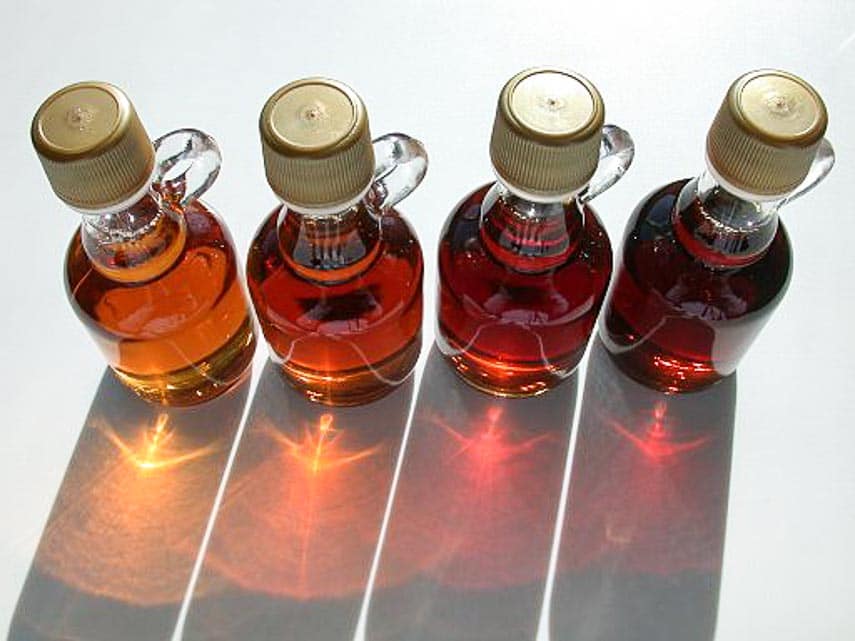
Monash low FODMAP serving size is suggested at 2 tablespoons (50 g).
FODMAP Friendly low FODMAP serving size is set at 2 ½ tablespoons (53 g).
We love pure maple syrup and it contains no FODMAPs whatsoever according to Monash and science of the sugars it contains. We love it and use it so much, that we have an entire article dedicated to it. Please see our Explore An Ingredient: Maple Syrup.
We have several recipes for you to try, like our Pork Loin with Maple Mustard Sauce.
- For our recipes we seek out local pure maple syrup. We are lucky living in New England!
Honey
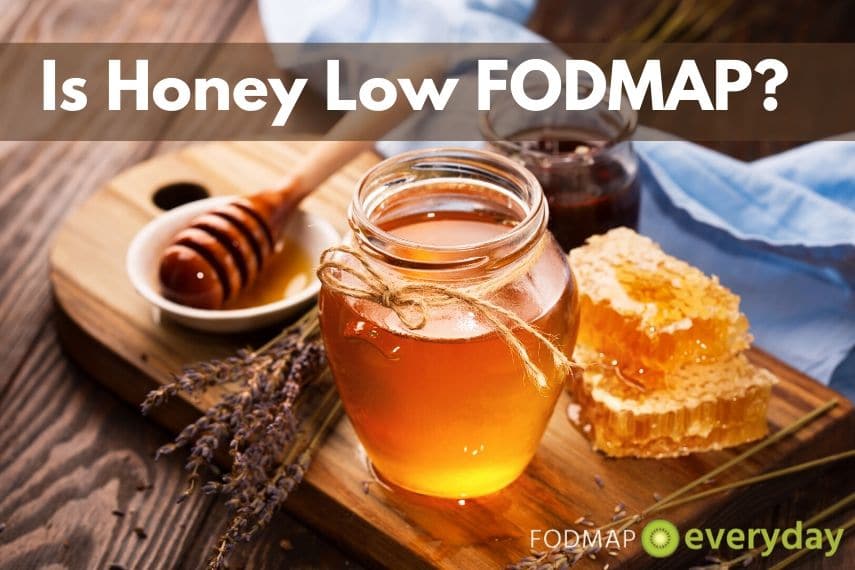
Monash University low FODMAP serving size of generic honey 1 teaspoon (7 g), becoming Moderate at 14 g, and High FODMAP at 28 g.
Monash University low FODMAP serving size of clover honey ½ teaspoon (3 g), becoming Moderate at 5 g, and High FODMAP at 20 g.
According to FODMAP Friendly, who have tested a generic honey, as well as Red Gum honey, their lab tests have shown no low FODMAP serving sizes.
Even small servings of honey are plenty to add flavor to cooking and baking, spread on bread with some butter, or stirred into tea. We have several low FODMAP recipes featuring honey, such as our Gluten-Free Low FODMAP Honey Cake.
Please read our article, Is Honey Low FODMAP?, for a deep dive.
- For our recipes we seek out local honey.
Agave

Monash University low FODMAP serving size for light and dark agave is 1 teaspoon (5 g). It becomes high FODMAP at 1 tablespoon (21 g).
FODMAP Friendly found no low FODMAP serving size for agave.
- MADHAVA Organic Light Agave is a great product, as is their dark version.
Brown Rice Syrup, Rice Malt Syrup, Rice Syrup
Monash University low FODMAP serving size of rice malt syrup is 1 tablespoon (28 g), but the small print tells us that it remains low FODMAP in servings of 500 g, the max that was tested.
FODMAP Friendly low FODMAP serving size of rice malt syrup is 1 ½ teaspoons or 10 g, with a max low FODMAP serve of 103 g. It contains fructans.
This mild, thick sweetener is a fantastic low FODMAP ingredient. We love it in our Chocolate Peanut Butter Energy Balls! It is pale, somewhat golden in color and even thicker than honey. Both Monash University and FODMAP Friendly have lab tested rice syrup.
- I use Lundberg Organic Brown Rice Syrup in our Test Kitchen.
Golden Syrup

Monash University low FODMAP serving size of golden syrup is 1 teaspoon (7 g), becoming Moderate at 12 g and High FODMAP at 15 g
FODMAP Friendly low FODMAP serving size of golden syrup is 1 teaspoon or 7 g, with a max low FODMAP serve of 21 g. It contains fructans.
Golden syrup is a gorgeous rich golden color and tastes like liquid butterscotch! Both Monash University and FODMAP Friendly have lab tested golden syrup. Try it in our Low FODMAP Chewy Peanut Butter Chocolate Chunk Cookies.
- I use Lyle’s Golden Syrup in our Test Kitchen.
Sorghum Syrup
Monash University low FODMAP serving size of sorghum syrup is 2 teaspoons (20 g), becoming Moderate for FODMAPs at 25 g, and High for FODMAPs at 40 g.
Monash University has lab tested sorghum syrup, which is a mild, liquid sweetener that deserves more attention.
Sorghum syrup is made from the green juice of the sorghum plant. Stalks are crushed, juice is extracted and then heated to steam off the excess water, leaving the syrup behind. You could try it in recipes that call for other liquid sweeteners.
Barley Malt Extract Syrup
Monash University has lab tested barley malt syrup. A low FODMAP serving is 12 g, or what they call ⅓ of a tablespoon, but remember those are Australian tablespoons. It contains fructans and becomes Moderate at 16 g, and high FODMAP at 35 g.
Barley malt extract syrup (sometimes called barley malt, or barley malt extract) is an unrefined sweetener made by extracting it from sprouted, malted barley. It is composed of approximately 65% maltose. Dark brown, thick, and sticky, barley malt syrup has a strong, distinctive “malty” flavor and is about half as sweet as refined white sugar. It is often combined with other natural sweeteners to impart a malt flavor. Sometimes referred to as “barley malt extract” or simply “malt syrup.”
- Give this sweetener a try. We like Eden brand.
Invert Sugar
FODMAP Friendly used to have an entry for invert sugar, which was removed during a previous update. Invert sugar is a liquid sweetener with equal amounts of glucose and fructose, therefore it is low FODMAP. You might see it listed as in ingredient in prepared foods.
Glucose
You might come across glucose as an ingredient in prepared products. Glucose is considered low FODMAP. It can be found in sweets as well as savory products (breads, BBQ sauces, etc.), and is used widely in confectionary goods.
Cane Syrup
Cane syrup has not been lab tested but should be low FODMAP, given its molecular structure, which is primarily invert sugar and sucrose.
Yacon Syrup
Yacon syrup has not been lab tested, but is believed to be high FODMAP.
Made from the tuberous roots of yacon plants that contain a significant amount of fructo-oligosaccharides (FOS) and inulin, which are known high FODMAP carbohydrates.
Corn Syrup Vs. High Fructose Corn Syrup

Corn syrup is mostly made of glucose and is low FODMAP.
Corn syrup and high fructose corn syrup (HFCS) are not the same thing. HFCS is predominantly fructose.
Please refer to our article, Corn Syrup vs. High-Fructose Corn Syrup, for a deeper dive.
Polyols
Polyols are the “P” in FODMAP and are high FODMAP. They are also called sugar alcohols. Polyols include sorbitol, xylitol, mannitol, maltitol, and isomalt and are all high FODMAP.
Look for them in prepared foods, such as “sugar-free” gums and candies, and even in medications.
Other Sugars, Sweeteners & Sugar Substitutes
You might come across ingredient labels or recipes calling for raw sugar, evaporated cane juice, turbinado sugar or other terms, which we will address briefly here.
Monash has tested and listed white, raw and brown sugars in their app. They have also told us (at one point) that they contain no FODMAPs, therefore, by extrapolation, any of the sugars in this section should be free of FODMAPs as well, and also should be eaten in moderation.
Monash has since altered their language and the way they present certain foods in their apps. As always, eat to your tolerance.
We updated this article to now also include honey, maple syrup, molasses, agave, rice syrup, golden syrup, and sorghum syrup.
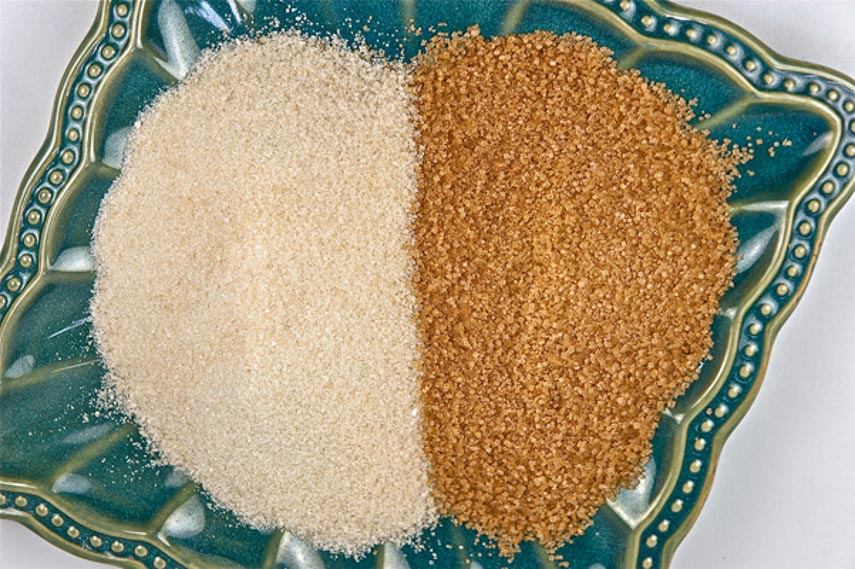
Evaporated Cane Juice/Raw Sugar/Natural Cane Sugar
These sugars have not been lab tested. They should be the same FODMAP-wise as white sugar, and are typically treated as such.
These are all terms used for a finely granulated sugar that is pale beige, due to the remaining molasses naturally occurring in the sugar cane. Unlike what most people assume, these are very much a processed product. They can be used cup-for-cup in recipes calling for white granulated sugar, although they often take longer to dissolve.
- Look for brands such as Bob’s Red Mill and Costco’s Kirkland label.
Turbinado/Demerara/Raw Sugar/Sugar in the Raw
Monash has lab tested raw sugar and has given a Green Light to servings of ¼ cup (50 g). Please note that as of fall 2022 Monash added a new app listing for “Demerara” and stated that low FODMAP servings are 1 teaspoon or 4g, with the sugar becoming Moderate for FODMAPs at ⅓ cup, or 75 g (later set at 73 g).
Always remember that many serving sizes listed in the app, like the 1 teaspoon (4 g) suggestion above, have less to do with FODMAPs and more to do with Australian healthy eating guidelines.
These are all terms for a slightly less processed type of granulated sugar, all with a darker beige color than those listed above and of white sugar. “Sugar in the Raw” is a brand that many people are familiar with (it’s the little brown packets at Starbucks), and it is a turbinado sugar. The terms Demerara and turbinado are often used interchangeably, although in general Demerara is coarser. The larger crystals mean that they will take longer to dissolve – when creaming with butter, for instance – but they can be used as a white-sugar substitute with some changes in outcome, mostly textural.
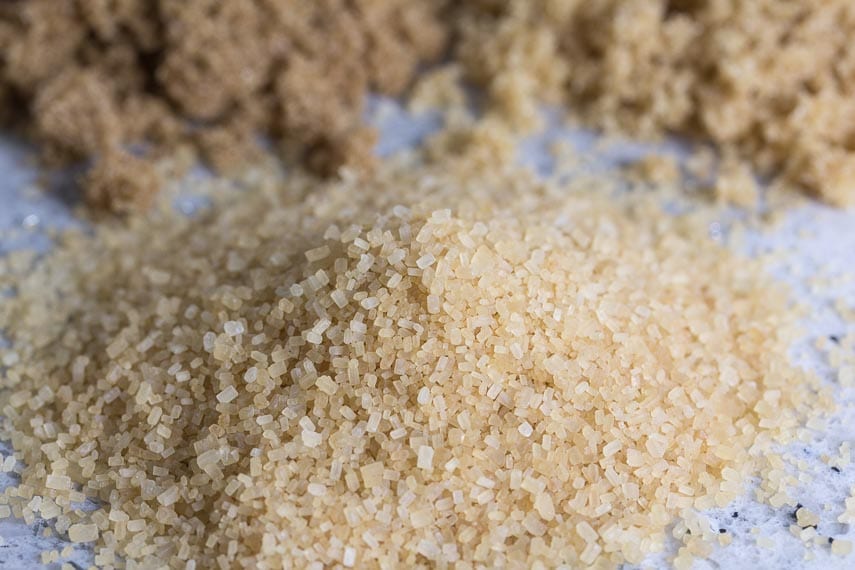
A simple description of the manufacturing process is that the cane juice, which is rich in molasses, vitamins and minerals, is extracted from the plant (pressed out). Solids are discarded, and the cane juice is boiled, evaporated and crystallized. The crystals are then heated and the natural molasses separates out through a process that involves a centrifuge or turbine-like machine – hence the name turbinado. The result is a beige, natural sugar, which is then washed and steamed. You can see that these sugars are not raw, but they are considered only partially refined.
Jaggery
Monash lists Jaggery on the smartphone app with a suggested ½ (Australian) tablespoon or a 12 g serving, becoming Moderate at 18 g, and High FODMAP at 24 g.
Jaggery is typically made from palm, coconut, or java plants and comes compressed into a cake or cone. We do not know what type Monash tested, which is unfortunate.
It has an earthy yet sweet flavor that we like with oatmeal and in some fruit crumble toppings. You will find it in specialty stores and those carrying Asian and Indian foods.
Coconut Sugar
Monash lists Coconut sugar on the smartphone app with a suggested 1 teaspoon (4 g) serving. According to Monash, 1 (Australian) tablespoon is high is both fructans and fructose.
FODMAP Friendly has lab tested coconut sugar as well. Their low FODMAP serving is also 1 teaspoon (4 g), but they also told us that their testing showed low FODMAP amounts up to 44 g, now adjusted to 24 g. These variations probably have to do with the production/manufacture of the coconut sugars tested. We are not given brand names by either Monash or FODMAP Friendly.
Please review these articles at this time:
- Monash University Lab Testing Explained
- FODMAP Friendly Lab Testing Explained
- When Monash University & FODMAP Friendly Lab Test Results Differ
To be more accurate, this product should be labeled coconut palm sugar – which is not the same as palm sugar, below.
Coconut sugar is made from the sap of the coconut palm (the same tree that gives you edible coconut). The sap is boiled down and dehydrated. It is a somewhat finely granulated product sporting a rich beige color. It is easier to find coconut sugar these days in stores such as Whole Foods or Thrive Market.
Palm Sugar
Monash lists Palm Sugar on the smartphone app with a suggested ¼ cup (40 g) serving.
Palm sugar comes from the sugar palm tree and common in Thai cuisine. It is made by boiling down and dehydrating the tree sap. It is also a somewhat finely granulated product with a rich beige color.
Fructose
Fructose is high FODMAP and is a monosaccharide, represented by the “M” in FODMAP.
Avoid any ingredients labeled as ‘fructose,’ including fructose isolate, fructose syrup, crystalline fructose, or fructose sugar, as they contain excess fructose, which is what makes it high FODMAP.
Dextrose
Dextrose is a type of sugar that is usually derived from corn or wheat. It is almost identical to glucose, and therefore low FODMAP. It can come in liquid or granular form and is typically an ingredient in prepared foods, not used as an ingredient in the home.
Fruit Sugar
Fruit sugar is an another name for fructose, which is high FODMAP. (See Fructose above).
It occurs naturally in many fruits and some vegetables.
Stevia
Monash originally listed stevia on their smartphone app with a suggested “2 sachets”/2 g serving. Now they state that a low FODMAP serving is 2 teaspoons (5 g).
Stevia is a sweetener and sugar substitute extracted from the leaves of the stevia rebaudiana Bertoni plant. It is native to South America, specifically Paraguay, but it is now grown in many tropical and sub-tropical climates.
The leaves are dried, then put through a water extraction and purification process. Stevia contains 8 glycosides, which are the sweet components of the plant.
The resulting product has zero calories, which is an attraction for many, and its sweetening power is commonly stated as about 150 times, and up to 350 times, sweeter than sugar, so very little is required. It can be used as an alternative sweetener for those with diabetes.
Monash has tested a granular form of stevia, but would not confirm the exact ingredients of the product testes, nor the brand that they tested.
Note that not all stevia products are the same and in fact some contain inulin, and/or fructose or sugar alcohols – all of which are high FODMAP. You must read labels.
Erythritol
Erythritol is within several lab tested certified low FODMAP products, which means some amount is low FODMAP. The testing certification bodies have not told anyone what the low FODMAP serving size is. Erythritol is different from other sugar alcohols in that is is digested before it reaches the colon. Individual tolerance will of course vary.
Monk Fruit
Monk fruit is within several lab tested certified low FODMAP products, which means some amount is low FODMAP. The testing certification bodies have not told anyone what the low FODMAP serving size is. Individual tolerance will of course vary.
Allulose
Allulose is another zero calorie sugar substitute. The brand Rx Sugar is a FODMAP Friendly lab tested and certified low FODMAP product. Individual tolerance will of course vary.
Snew
Snew is a FODMAP Friendly lab tested and certified low FODMAP product. It is a balanced mix of low FODMAP polyol, fiber and sweeteners that do not cause abdominal discomfort. According to the manufacturer, Snew is an innovative sugar substitute that can be used in the same proportion as traditional sugar in recipes. This product is a unique blend of natural ingredients derived from vegetables and it is perfect for cooking, baking and sweetening culinary preparations in the same measure of sugar and without residual flavour. Individual tolerance will of course vary.
Aspartame
Equal, NutraSweet, and Sugar Twin are all aspartame. It is untested, but likely low FODMAP due to its chemical structure, which is made up of amino acids (proteins) and not carbohydrates.
Saccharin
Sweet ‘N Low, Sweet Twin, and Necta Sweet are all brands of saccharin. It is untested, but considered low FODMAP.
Saccharin is commonly used in many diet foods and beverages and as a tabletop sweetener. It is available in both granule and liquid forms.
Sucralose
Sucralose is marketed as Splenda, possibly the world’s most popular no-calorie sweetener. It is un-tested but considered low FODMAP due to its chemical structure. The majority of it is not even digested.
Sucralose molecules contain not only carbon, hydrogen and oxygen, but also chlorine. You might find it listed in prepared food’s ingredient lists. Some animal studies have shown that long-term use can disrupt the gut microbiome and increase inflammation.
Non-Nutritive Sweeteners and Gut Health
Non-nutritive sweeteners are sugar substitutes that have a low-calorie content and are usually several hundred thousand times sweeter than regular white sugar. Their consumption is growing because of their low-calorie content and the health concerns about products with high sugar content.
They include synthetic sweeteners such as acesulfame K, aspartame, cyclamate, saccharin and sucralose as well as natural sweeteners like monk fruit and stevia. Although non-nutritive sweeteners are considered low FODMAP, their effects on glucose intolerance, the activation of sweet taste receptors, and alterations to the composition of the intestinal microbiota are controversial. According to studies, only saccharin (found in Sweet’N Low and SugarTwin), sucralose (found in Splenda) and stevia have been found to change the composition of the gut microbiota.
While it is possible that this might cause glucose intolerance and dysbiosis, more human studies are needed. It is also interesting to know that only 15% of the consumed saccharin reaches the colon, compared to 85% for sucralose, so saccharin needs to be consumed in large amounts to potentially alter the gut. Also, sucralose is not metabolized by intestinal bacteria, while stevia directly interacts with the intestinal microbiota and needs bacteria to be metabolized, so stevia might cause greater alteration to the bacterial population in the gut.
Takeaway Message Re: Non-Nutritive Sweeteners
Since we still don’t know how exactly saccharin, sucralose, stevia and monk fruit affect gut health, especially long term, and that there is a possibility that they can negatively impact it, it is preferable to use caution and consume those sweeteners in moderation, even if they are considered low FODMAP.
How to Use Sugar
We have offered some information throughout this article as to the brands of sugars that we use and we encourage you to use whatever sweetener is recommended in individual recipes.
Substituting Sugars In Recipes
Sugars and sweeteners not only add sweetness to recipes. They also greatly affects structure and texture. Well-developed recipes are made up of specific ratios of ingredients. We always suggest you make a recipe exactly as written the first time you make it. If you want to try making substitutions, start by substituting granular for granular, and liquid for liquid. In other words, if a recipe calls for white sugar, do no use maple syrup.
We do not use stevia or any NNS in the Test Kitchen. We do NOT suggest that you substitute any sugar substitutes or NNS (non-nutritive sweeteners) in our recipes.
Can I Reduce Sugar In Recipes?
Sugar adds sweetness as well as structure and texture in recipes. If you want to try reducing sugar, try by 25%. You might also be interested in our Lower fat, Reduced Sugar Banana Bread.
How to Store & Measure Sugar
We transfer granulated sugars from their packages and store them in glass or plastic airtight containers. This makes them particularly handy to measure, as we use a dip-and-sweep method in the Test Kitchen for loose granulated sugars. For moist brown sugars, we pack firmly in the specific size measuring cup that is called for (¾ cup, ¼ cup etc.).
For liquid sweeteners, please use a liquid measuring cup for measuring larger amounts, or measuring spoons for smaller.
The Takeaway
Sugar can be included in your low FODMAP diet, even if you are in the Elimination Phase, although it is recommended that you consume in small amounts, and as an occasional indulgence, for general nutritional health.
The issue with sugar in many diets, such as the typical American diet, is that it is hidden in so many foods, such as condiments (like ketchup, mayonnaise), sodas, snack foods, even breads. The issue is not having an occasional slice of birthday cake, muffin, or dessert when dining out, or at a party.
Work with your Registered Dietitian to assess your own tolerances and needs and then take advantage of our sweet recipes.
Low FODMAP Recipes with Low FODMAP Amounts of Sugar
Here are just a few of our community’s favorite sweet treats; we have many more. Please note that the amount of sugar that is low FODMAP is per serving.
- Low FODMAP Mocha Toffee Crunch Cake
- One-Bowl Low FODMAP Peanut Butter Oatmeal Chocolate Chunk Cookies with Raisins
- Low FODMAP Mixed Berry Slab Pavlova
- The BEST Low FODMAP Blueberry Muffins
- Low FODMAP Decadent Chocolate Brownies
- Low FODMAP One-Bowl Peanut Butter Cookies
- Low FODMAP Poppy Seed Carrot Banana Bread
- Low FODMAP Fluffy Pancakes
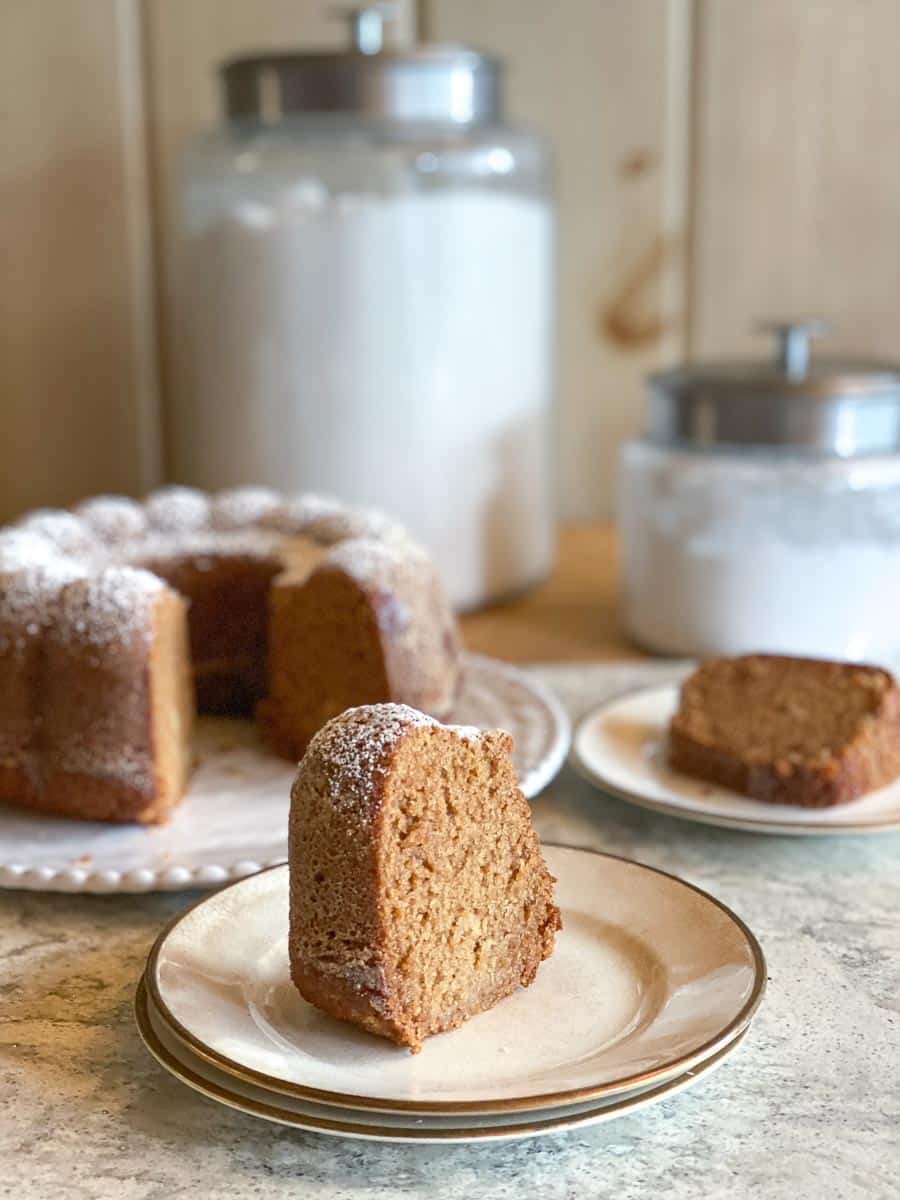
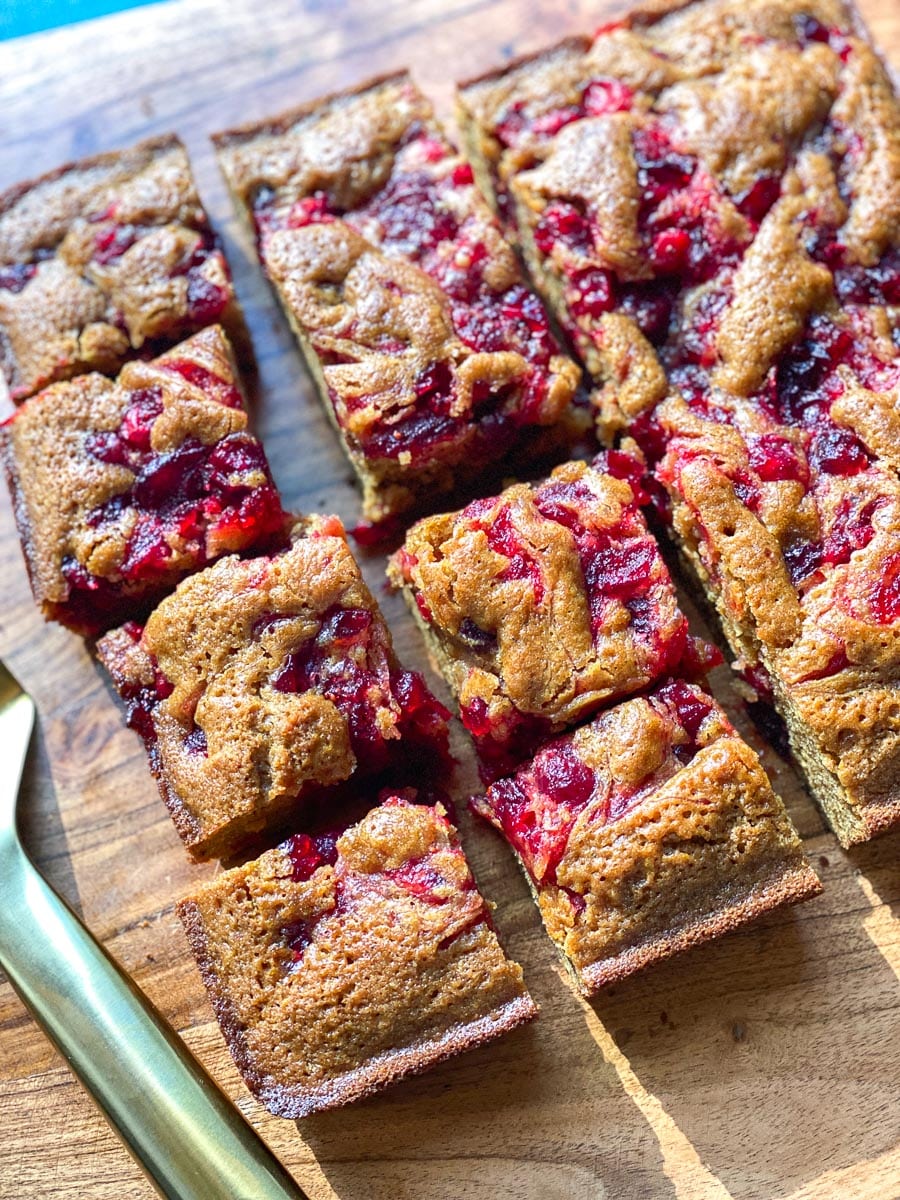
References
Sugarcane, via ScienceDirect, by João Nunes de Vasconcelos, 2015.
USDA on Molasses sugar content.
